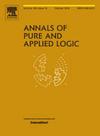向上Löwenheim-Skolem-Tarski数字抽象逻辑
IF 0.6
2区 数学
Q2 LOGIC
引用次数: 0
摘要
Galeotti, Khomskii和Väänänen最近为逻辑引入了向上Löwenheim-Skolem-Tarski数的概念,加强了汉夫数的经典概念。基数κ是逻辑L的向上Löwenheim-Skolem-Tarski数(ULST数),如果它是具有以下性质的最小基数:每当M是大小至少κ的模型满足L中的句子φ时,则存在满足φ且M为子结构的任意大模型。子结构要求是ULST数与汉夫数的区别,并赋予了大基数强度的概念。虽然每个逻辑都有一个汉夫数是ZFC的一个定理,但Galeotti、Khomskii和Väänänen证明了二阶逻辑的ULST数的存在意味着部分可扩展基数的存在。我们肯定地回答了他们关于二阶逻辑的ULST数是最小可扩展基数的猜想。我们通过将子结构要求强化为基本子结构来定义强ULST数。我们研究了几种经典强逻辑的ULST和强ULST数:无限逻辑、等价逻辑、良基量词逻辑、二阶逻辑和排序逻辑。我们表明,在某些情况下,ULST和强ULST数的特征是经典的大基数,而在某些情况下,特征是由它们产生的自然的新的大基数概念。我们证明了在某些逻辑中,ULST数、强ULST数和最弱紧性的概念基本重合,而在另一些逻辑中,它们可以分开是一致的。最后,我们引入了一个自然大基数概念,表征了等价逻辑的强紧性基数。本文章由计算机程序翻译,如有差异,请以英文原文为准。
Upward Löwenheim-Skolem-Tarski numbers for abstract logics
Galeotti, Khomskii and Väänänen recently introduced the notion of the upward Löwenheim-Skolem-Tarski number for a logic, strengthening the classical notion of a Hanf number. A cardinal κ is the upward Löwenheim-Skolem-Tarski number (ULST number) of a logic if it is the least cardinal with the property that whenever M is a model of size at least κ satisfying a sentence φ in , then there are arbitrarily large models satisfying φ and having M as a substructure. The substructure requirement is what differentiates the ULST number from the Hanf number and gives the notion large cardinal strength. While it is a theorem of ZFC that every logic has a Hanf number, Galeotti, Khomskii and Väänänen showed that the existence of the ULST number for second-order logic implies the existence of a partially extendible cardinal. We answer positively their conjecture that the ULST number for second-order logic is the least extendible cardinal.
We define the strong ULST number by strengthening the substructure requirement to elementary substructure. We investigate the ULST and strong ULST numbers for several classical strong logics: infinitary logics, the equicardinality logic, logic with the well-foundedness quantifier, second-order logic, and sort logics. We show that the ULST and the strong ULST numbers are characterized in some cases by classical large cardinals and in some cases by natural new large cardinal notions that they give rise to. We show that for some logics the notions of the ULST number, strong ULST number and least strong compactness cardinal coincide, while for others, it is consistent that they can be separated. Finally, we introduce a natural large cardinal notion characterizing strong compactness cardinals for the equicardinality logic.
求助全文
通过发布文献求助,成功后即可免费获取论文全文。
去求助
来源期刊
CiteScore
1.40
自引率
12.50%
发文量
78
审稿时长
200 days
期刊介绍:
The journal Annals of Pure and Applied Logic publishes high quality papers in all areas of mathematical logic as well as applications of logic in mathematics, in theoretical computer science and in other related disciplines. All submissions to the journal should be mathematically correct, well written (preferably in English)and contain relevant new results that are of significant interest to a substantial number of logicians. The journal also considers submissions that are somewhat too long to be published by other journals while being too short to form a separate memoir provided that they are of particular outstanding quality and broad interest. In addition, Annals of Pure and Applied Logic occasionally publishes special issues of selected papers from well-chosen conferences in pure and applied logic.

 求助内容:
求助内容: 应助结果提醒方式:
应助结果提醒方式:


